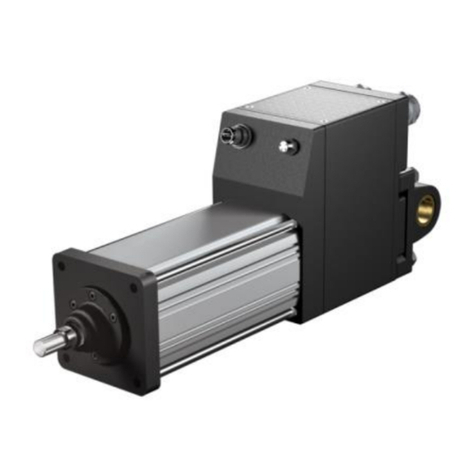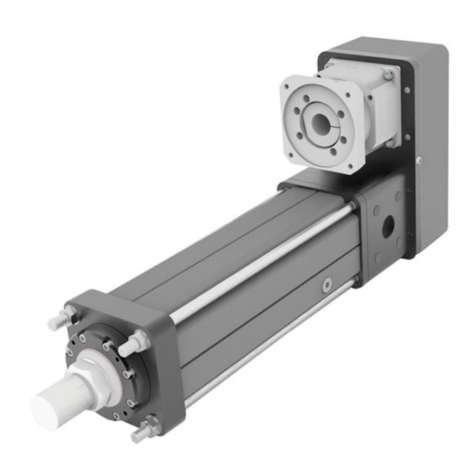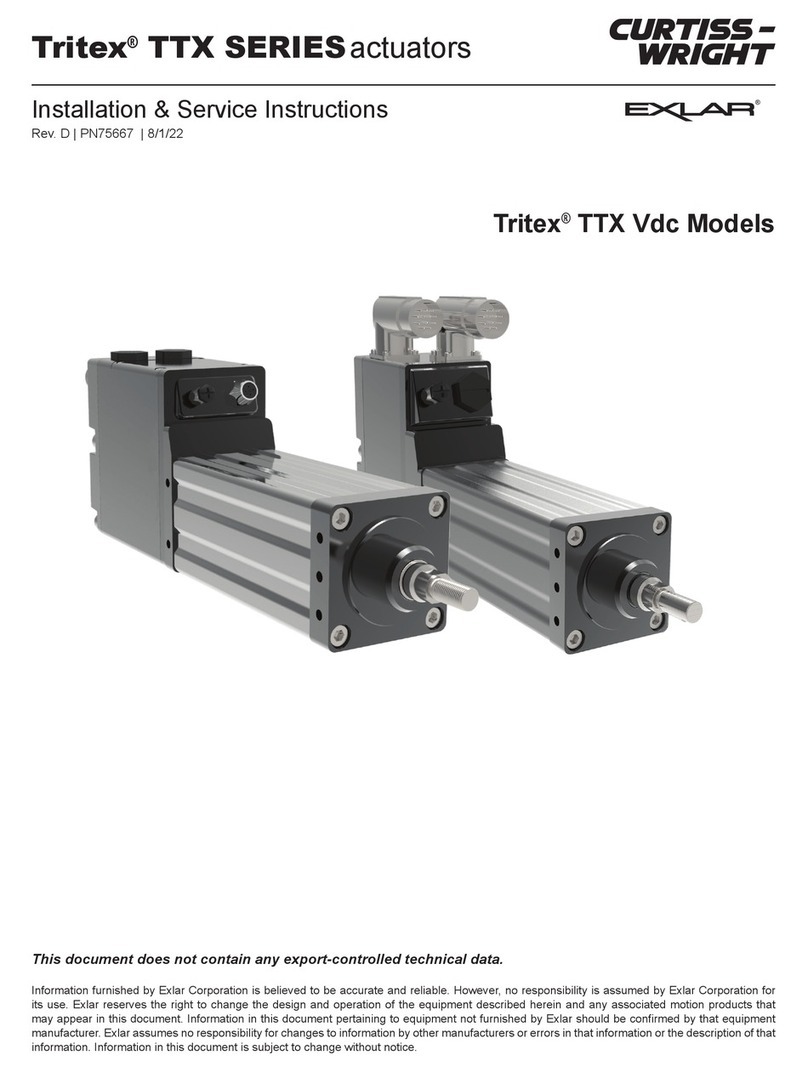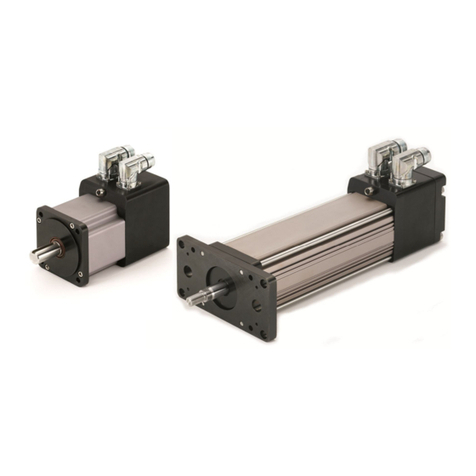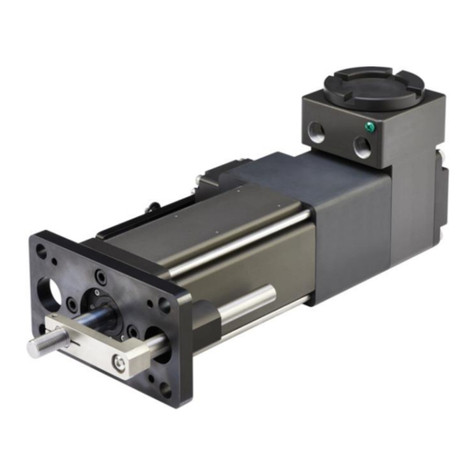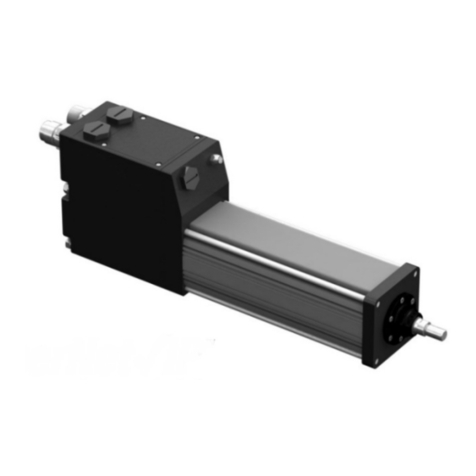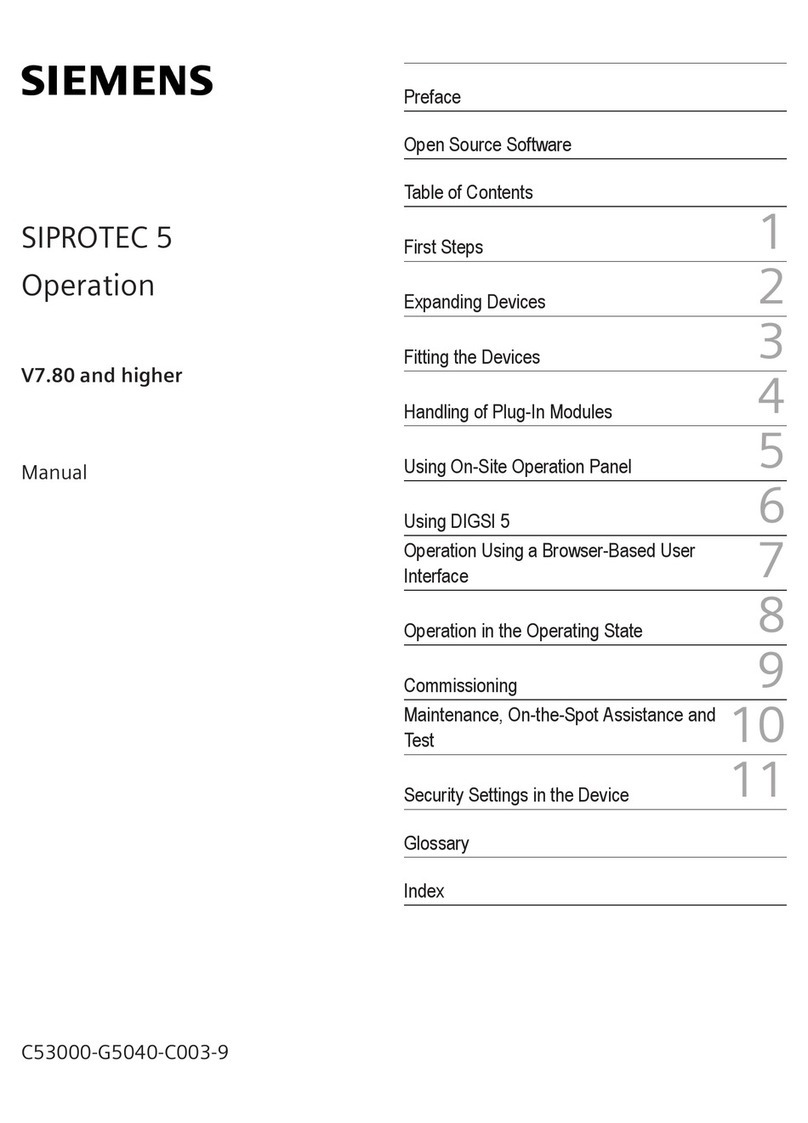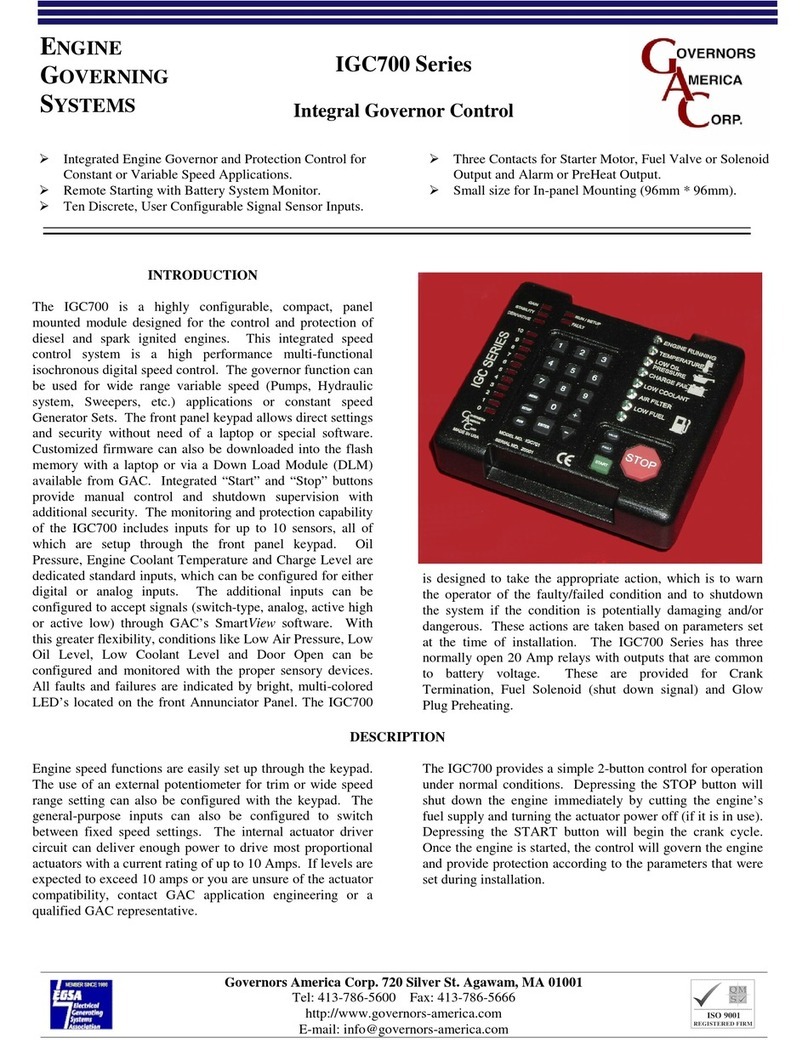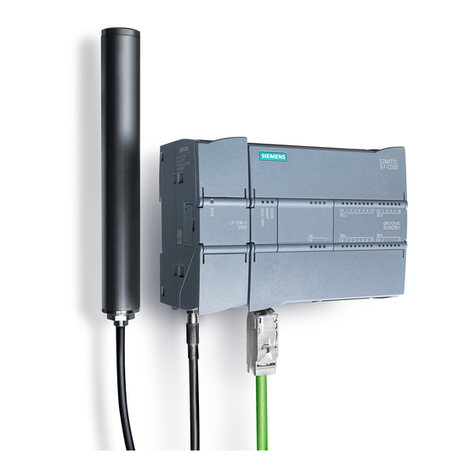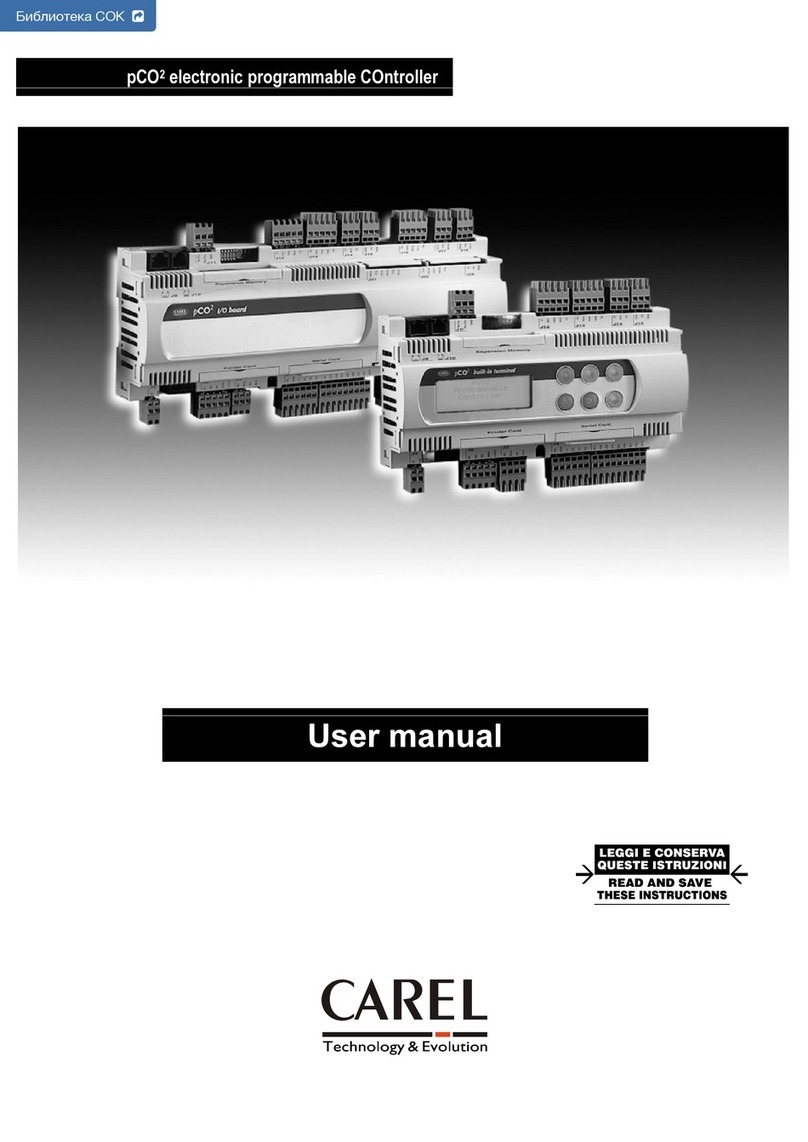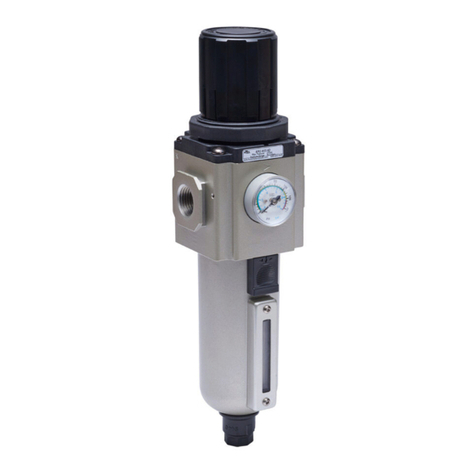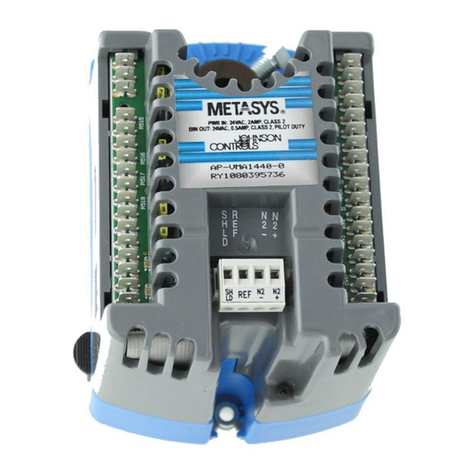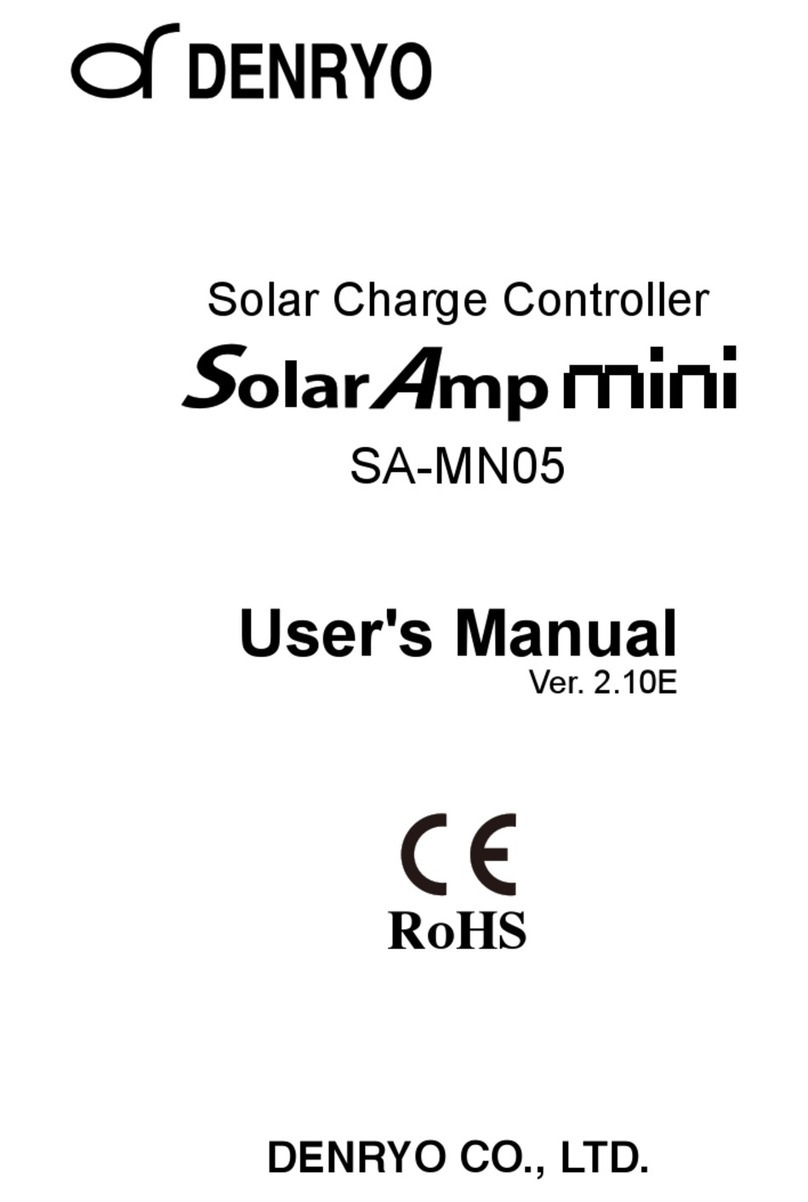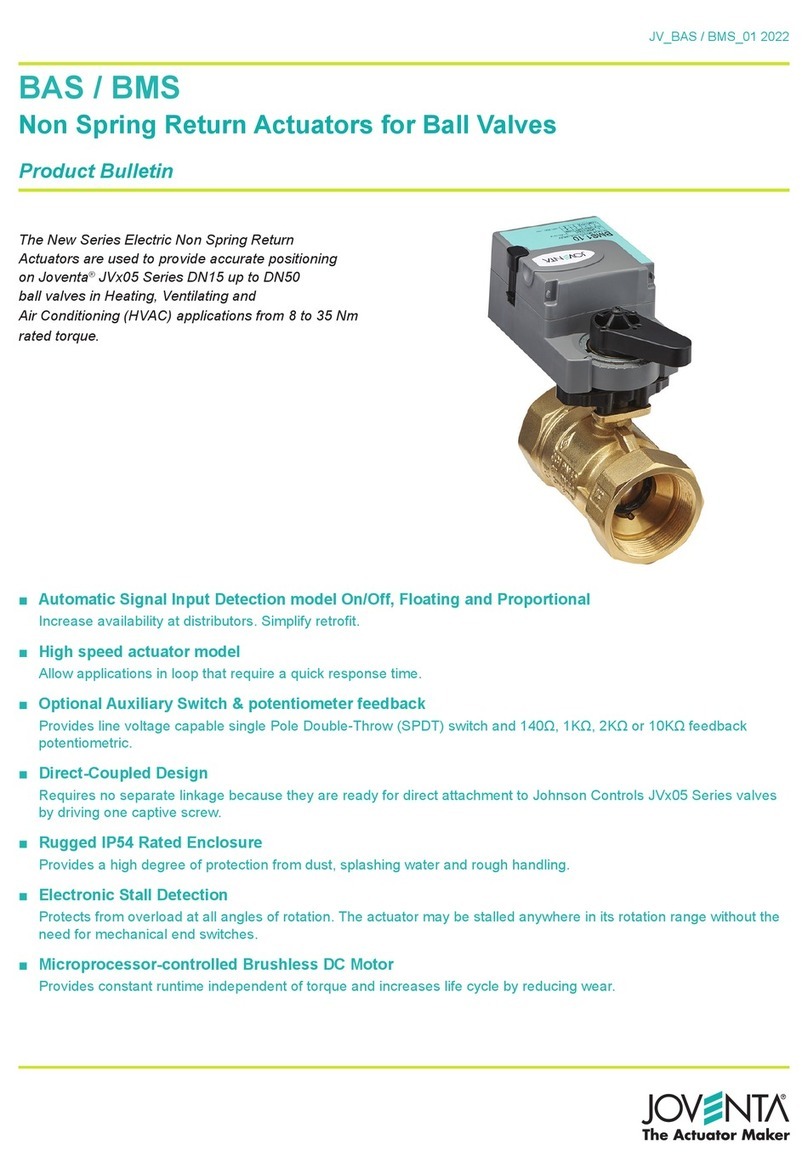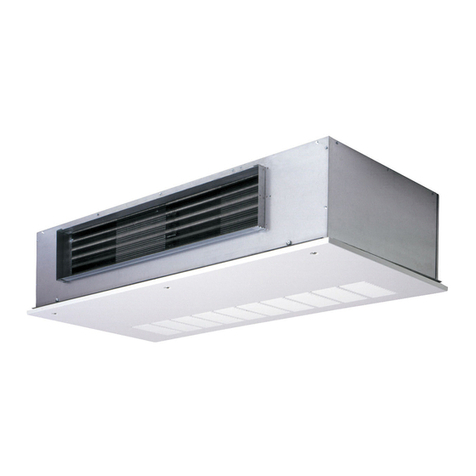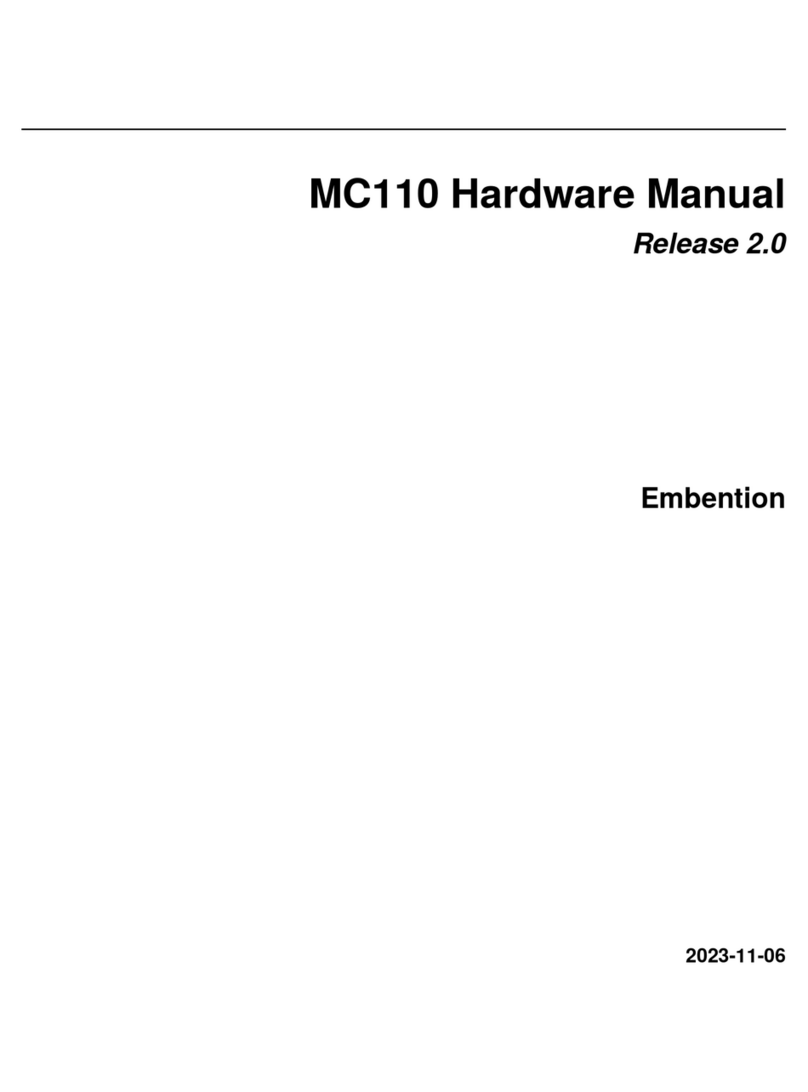Exlar GSX Series Manual

GS/X Manual.doc 102/17/14
PN: 10278 Exlar Corporation
Rev. KK 952-500-6200
GSX and GS SERIES LINEAR ACTUATOR
INSTALLATION AND SERVICE MANUAL
Information furnished by EXLAR Corporation is believed to be accurate and reliable. However, no responsibility is assumed by EXLAR
Corporation for its use. EXLAR reserves the right to change the design and operation of the equipment described herein and any associated
motion products that may appear in this document. Information in this document pertaining to equipment not furnished by EXLAR should be
confirmed by that equipment manufacturer. EXLAR assumes no responsibility for changes to information by other manufacturers or errors in that
information or the description of that information. Information in this document is subject to change without notice.

GS/X Manual.doc 202/17/14
PN: 10278 Exlar Corporation
Rev. KK 952-500-6200
TABLE OF CONTENTS
1.0 Introduction
1.1 Warranty and Limitations of Liability. . . . . . . . . . . . . . . . . . . . . . . . . . . . . . . . 3
1.2 Safety Considerations . . . . . . . . . . . . . . . . . . . . . . . . . . . . . . . . . . . . . . 4
2.0 System Configuration . . . . . . . . . . . . . . . . . . . . . . . . . . . . . . . . . . . . . . . . . . 5
2.1 Typical System Configuration . . . . . . . . . . . . . . . . . . . . . . . . . . . . . . . . . 5
2.2 Standard Actuator Pin-outs and Connections . . . . . . . . . . . . . . . . . . . . . . . . . . 6
2.3 Feedback Information . . . . . . . . . . . . . . . . . . . . . . . . . . . . . . . . . . . . . 6
2.4 Cable Routing . . . . . . . . . . . . . . . . . . . . . . . . . . . . . . . . . . . . . . . . . . 7
2.5 Internal Holding Brake . . . . . . . . . . . . . . . . . . . . . . . . . . . . . . . . . . . . . . 7
2.6 External Limit Switches . . . . . . . . . . . . . . . . . . . . . . . . . . . . . . . . . . . . . . 9
2.7 Brake Extensions . . . . . . . . . . . . . . . . . . . . . . . . . . . . . . . . . . . . . . . . . 10
2.8 Anti-Rotation Option . . . . . . . . . . . . . . . . . . . . . . . . . . . . . . . . . . . . . . . . 11
2.9 Ingress Protection . . . . . . . . . . . . . . . . . . . . . . . . . . . . . . . . . . . . . . . . 12
3.0 Installation and Operation . . . . . . . . . . . . . . . . . . . . . . . . . . . . . . . . . . . . . . . . 13
3.1 Lubrication Requirements . . . . . . . . . . . . . . . . . . . . . . . . . . . . . . . . . . . . 13
3.2 Grease Lubrication . . . . . . . . . . . . . . . . . . . . . . . . . . . . . . . . . . . . . . . . 14
3.3 Oil Lubrication . . . . . . . . . . . . . . . . . . . . . . . . . . . . . . . . . . . . . . . . . . 14
3.4 Mounting Configurations . . . . . . . . . . . . . . . . . . . . . . . . . . . . . . . . . . . . . 15
3.5 Mounting Considerations . . . . . . . . . . . . . . . . . . . . . . . . . . . . . . . . . . . . . .16
3.6 General Operation . . . . . . . . . . . . . . . . . . . . . . . . . . . . . . . . . . . . . . . . 16
3.7 Manual Drive Operating Instructions . . . . . . . . . . . . . . . . . . . . . . . . . . . . . . . 18
4.0 Maintenance Procedures . . . . . . . . . . . . . . . . . . . . . . . . . . . . . . . . . . . . . . . . . 19
4.1 Disassembly . . . . . . . . . . . . . . . . . . . . . . . . . . . . . . . . . . . . . . . . . . . 19
4.2 Lubrication Maintenance . . . . . . . . . . . . . . . . . . . . . . . . . . . . . . . . . . . . . 20
4.3 Reassembly . . . . . . . . . . . . . . . . . . . . . . . . . . . . . . . . . . . . . . . . . . . 21
4.4 Seal Maintenance . . . . . . . . . . . . . . . . . . . . . . . . . . . . . . . . . . . . . . . . 22
5.0 Troubleshooting Procedures . . . . . . . . . . . . . . . . . . . . . . . . . . . . . . . . . . . . . . 24
5.1 Returning a Product for Repair . . . . . . . . . . . . . . . . . . . . . . . . . . . . . . . . . 25
6.0 GSX Force Measuring Option. . . . . . . . . . . . . . . . . . . . . . . . . . . . . . . . . . . . . . 26
6.1 Overview . . . . . . . . . . . . . . . . . . . . . . . . . . . . . . . . . . . . . . . . . . . . 26
6.2 Specifications and Calibration Data . . . . . . . . . . . . . . . . . . . . . . . . . . . . . . . 26
6.3 Operation . . . . . . . . . . . . . . . . . . . . . . . . . . . . . . . . . . . . . . . . . . . 26
6.4 Wiring Code . . . . . . . . . . . . . . . . . . . . . . . . . . . . . . . . . . . . . . . . . . . 26
7.0 Class I Division 2 Option . . . . . . . . . . . . . . . . . . . . . . . . . . . . . . . . . . . . . . . . 27
7.1 Terminal Box Wiring Diagram . . . . . . . . . . . . . . . . . . . . . . . . . . . . . . . . . . 27
7.2 Class I Div 2 Terminal Box Terminations . . . . . . . . . . . . . . . . . . . . . . . . . . . . 28
7.3 Terminal Box Dimensions . . . . . . . . . . . . . . . . . . . . . . . . . . . . . . . . . . . . 29
8.0 Certifications . . . . . . . . . . . . . . . . . . . . . . . . . . . . . . . . . . . . . . . . . . . . . . 30
Please visit www.exlar.com for information pertaining to connectors and cables.

GS/X Manual.doc 302/17/14
PN: 10278 Exlar Corporation
Rev. KK 952-500-6200
1.0 INTRODUCTION
1.1 Warranty and Limitation of Liability
Products are warranted for two years from date of manufacture as determined by the serial number on the product
label. Labels are generated and applied to the product at the time of shipment. The first and second digits are the year and
the third and fourth digits represent the manufacturing week. Product repairs are warranted for 90 days from the date of
the repair. The date of repair is recorded within Exlar Corporation’s database tracked by individual product serial number.
Exlar warrants its product(s) to the original purchaser and in the case of original equipment manufacturers, to their
original customer to be free from defects in material and workmanship and to be made only in accordance with Exlar's
standard published catalog specifications for the product(s) as published at the time of purchase. Warranty or
performance to any other specifications is not covered by this warranty unless otherwise agreed to in writing by Exlar and
documented as part of any and all contracts, including but not limited to purchase orders, sales orders, order
confirmations, purchase contracts and purchase agreements. In no event shall Exlar be liable or have any responsibility
under such warranty if the product(s) has been improperly stored, installed, used or maintained, or if Buyer has permitted
any unauthorized modifications, adjustments and/or repairs to such product(s). Seller's obligation hereunder is limited
solely to repairing or replacing (at its opinion), at the factory any product(s), or parts thereof, which prove to Seller's
satisfaction to be defective as a result of defective materials, or workmanship and within the period of time, in accordance
with the Seller's stated product warranty (see Terms and Conditions above), provided, however, that written notice of
claimed defects shall have been given to Exlar within thirty (30) days from the date of any such defect is first discovered.
The product(s) claimed to be defective must be returned to Exlar, transportation prepaid by Buyer, with written
specification of the claimed defect. Evidence acceptable to Exlar must be furnished that the claimed defects were not
caused by misuse, abuse, or neglect by anyone other than Exlar.
Components such as seals, wipers, bearings, brakes, bushings, gears, splines, and roller screw parts are considered
wear parts and must be inspected and serviced on a regular basis. Any damage caused by failure to properly lubricate
Exlar products and/or to replace wear parts at appropriate times, is not covered by this warranty. Any damage due to
excessive loading is not covered by this warranty.
The use of products or components under load such that they reach the end of their expected life is a normal
characteristic of the application of mechanical products. Reaching the end of a product’s expected life does not indicate
any defect in material or workmanship and is not covered by this warranty.
Costs for shipment of units returned to the factory for warranty repairs are the responsibility of the owner of the
product. Exlar will return ship all warranty repairs or replacements via UPS Ground at no cost to the customer.
For international customers, Exlar will return ship warranty repairs or replacements via UPS Expedited Service and
cover the associated shipping costs. Any VAT or local country taxes are the responsibility of the owner of the product.
The foregoing warranty is in lieu of all other warranties (except as Title), whether expressed or implied, including
without limitation, any warranty of merchantability, or of fitness for any particular purpose, other than as expressly set
forth and to the extent specified herein, and is in lieu of all other obligations or liabilities on the part of Exlar.
Seller's maximum liability with respect to these terms and conditions and any resulting sale, arising from any cause
whatsoever, including without limitation, breach of contract or negligence, shall not exceed the price specified herein of
the product(s) giving rise to the claim, and in no event shall Exlar be liable under this warranty otherwise for special,
incidental or consequential damages, whether similar or dissimilar, of any nature arising or resulting from the purchase,
installation, removal, repair, operation, use or breakdown of the product(s) or any other cause whatsoever, including
negligence.
The foregoing warranty shall also apply to products or parts which have been repaired or replaced pursuant to such
warranty, and within the period of time, in accordance with Seller's stated warranty.
NO PERSON INCLUDING ANY AGENT OR REPRESENTATIVE OF EXLAR, IS AUTHORIZED TO
MAKE ANY REPRESENTATION OR WARRANTY ON BEHALF OF EXLAR CONCERNING ANY
PRODUCTS MANUFACTURED BY EXLAR, EXCEPT TO REFER PURCHASERS TO THIS WARRANTY.

GS/X Manual.doc 402/17/14
PN: 10278 Exlar Corporation
Rev. KK 952-500-6200
1.2 Safety Considerations
As with any electro-mechanical device, safety should be considered during the installation and
operation of your GS/X Series actuator. Throughout this manual you will see paragraphs marked
with CAUTION and WARNING signs as shown below.
Pay particular attention to these paragraphs. They are intended to provide you with helpful
information to ensure safe and trouble-free installation.
CAUTION
WARNING

GS/X Manual.doc 502/17/14
PN: 10278 Exlar Corporation
Rev. KK 952-500-6200
2.0 SYSTEM CONFIGURATION
2.1 GS/X Series Actuator System Configuration
GS/X Series actuators incorporate an integral brushless servo motor. The design of this motor and selection of the
proper feedback configuration allows GS/X Series actuators to be powered by nearly every brand of brushless motor
amplifier on the market.
This flexibility allows GS/X Series actuators to be incorporated into the highest performance single and multi-axis
motion control systems in use today. In applications varying from food and beverage packaging to multi-axis
turning centers to aircraft assembly, the GS/X Series of actuators show incredible performance and durability.
The high torque to volume ratio available from a brushless motor, combined with the robust, high speed and high
load capability of the planetary roller screw, make the Exlar line of linear actuators a true, all electric replacement for
cumbersome high maintenance hydraulics. The use of electronic servo control provides simpler set up and more
precise control than hydraulic systems as well. Shown below is a typical single axis system incorporating an Exlar
GS/X Series actuator and a brushless motor amplifier.
Each brand of brushless motor amplifiers may have unique wiring requirements, parameter settings and operational
principles that affect how the actuator operates. The drawing on the following page shows general connection
principles for typical resolver and encoder feedback amplifiers. Details on connections to specific brands of
amplifiers can be obtained from www.exlar.com.
WARNING: Attempting to connect the power cable to the motor feedback connector may cause
damage to the connector. Verify that pin patterns match before attempting to connect cables to
actuator.
Never attempt to connect or disconnect the actuator with power applied. Dangerous voltages are
present. Damage to equipment and injury to personnel can result. Many amplifiers have voltage
present for a considerable time period after incoming power is removed. Take care to insure that
the amplifier has discharged all power.
Typical System Connections
(Please refer to www.exlar.com

GS/X Manual.doc 602/17/14
PN: 10278 Exlar Corporation
Rev. KK 952-500-6200
2.2 Standard Actuator Pin-outs and Connections
Please refer to www.exlar.com.
2.3 Feedback Information
Most GS/X Series actuators incorporate a 2 pole resolver or quadrature incremental encoder with
commutation signals as the primary rotary feedback device. The selection of this feedback device is dictated
by the amplifier used to operate the actuator. This amplifier is indicated in the model number of the GS/X
Series actuator as a 3 digit code.
Each amplifier has specific requirements for the feedback on the motor. Not all resolver-based amplifiers can
use the same resolver, resolver alignment, or relative direction of resolver rotation. Not all encoder-based
amplifiers can use the same encoder, encoder alignment or relative direction of encoder rotation.
Many amplifiers offer software that allows the entering of parameters or the downloading of "motor data
files" that dictate how the feedback must be set up on the motor. Exlar can provide many of these "motor
files" or the proper parameters to enter. Entering motor parameter data to some amplifiers may require
assistance from the amplifier manufacturer.
Feedback Alignment
When Exlar manufactures a GS/X Series actuator, the proper feedback is selected, mounted, aligned and test
run on the amplifier that the customer plans to use, or one that is known to be equivalent for confirming
proper feedback alignment and operation. In any case where it is determined that the feedback has become
misaligned, or an amplifier change is made requiring the feedback to be aligned differently, it is
recommended that Exlar be contacted and arrangements made to have that procedure performed.
Feedback Wiring
The wiring of the feedback device is critical to the operation of the actuator with the selected amplifier.
Improperly wiring the feedback cable can cause unstable operation, incorrect operation or no operation at all.
In some cases, improper current limits set in the amplifier, along with incorrect wiring of the feedback cable
can lead to damage of the motor.
Resolvers
A resolver is a non-electronic device that works like a small transformer. When rotated, it generates two sine
waves that are out of phase with one another. By decoding these two sine waves, the amplifier can monitor
the direction, revolutions traveled, and speed of rotation of the motor. Each sine wave typically represents
one revolution of the motor, so the amplifier can also use these signals to know where the motor is within that
revolution. By knowing the motor's position, the amplifier can properly time the supply of current and
voltage to the motor for it to rotate. This process is commutation. For the amplifier to properly commutate
the motor, it must have a reference, or zero, point from which to track the motor's rotation. This reference
point is critical, and is provided to the amplifier through the proper alignment of the resolver to the phases of
the motor during the actuator assembly.
Encoders
An incremental encoder is an electronic rotary device that transmits a string of electrical pulses when rotated.
Most brushless motors or servo systems that use incremental encoders use what is called a quadrature
encoder. Typical brushless motor encoders use two data channels labeled A&B to provide direction, velocity
and position information. The Channel labeled I or Z has one pulse per revolution and is called the index.
The channels labeled as hall signals or commutation signals are typically labeled S1, S2 & S3; Hall 1, 2 & 3;
or Hall A, B & C, depending on the manufacturer's conventions. These signals give the amplifier the
commutation information that it needs to properly rotate the motor.

GS/X Manual.doc 702/17/14
PN: 10278 Exlar Corporation
Rev. KK 952-500-6200
GS/X Series Feedback Devices
Standard GS/X Series actuators use either resolvers or encoders as their primary feedback device. Depending
on the amplifier that will be used to operate the actuator, the hookup of the actuator can vary. Go to
www.exlar.com, or contact Exlar for the correct wiring details.
2.4 Cable Routing
Over time, liquid contaminants such as oil and cleaning solutions will run down the cables and into the
connectors if they are of an exposed type. To minimize the introduction of contaminants to the connector,
route the cables so that there is a loop in the cable just prior to its attachment to the connector.
Two examples are shown below depending on the orientation of the connectors. Units mounted in such a
way that the connectors are on the bottom surface of the actuator require no looping.
2.5 Internal Holding Brake
Many applications require the addition of the Exlar internal holding brake. The brake is held open by the
supply of power to a magnetic/mechanical clutch. Whenever there is not power to the brake, the armature is
held in place which prevents the inverted roller screw from turning and prevents the output rod from back
driving, which in turn prevents the output rod from moving.
The RB holding brake is permanent magnet engaged, the EB is spring engaged and both are electrically
released. The mechanical advantage of the roller screw allows the holding brake to prevent back driving of
the load. The holding capacity of the brakes is sufficient to hold the rated force of the actuator when used in
grease lubricated units. The use of oil as a lubricant reduces the holding capacity of the brake.
Historically, Exlar actuators and motors which had holding brakes are supplied with a transient suppression diode
which can be wired to the actuator or motor brake connector. With the changes in servo amplifier and control
technology, there are now instances where the diode is not required to be within the motor. An example of this is a
control system using a dedicated brake control relay which contains transient suppression components.
Top Mount Loop
Side Mount Loop

GS/X Manual.doc 802/17/14
PN: 10278 Exlar Corporation
Rev. KK 952-500-6200
Because of this change in technology, Exlar now provides the transient suppression diode separately from the
actuator, for inclusion in the brake control circuitry as needed by the end user. A schematic, shown below, is
provided with the shipped product showing the typical use of the transient suppression diode.
If the user is uncertain about their requirements for transient suppression, they should refer to their servo amplifier or
controller technical documentation, or contact their servo amplifier or controller manufacturer for technical support.
For connection of your amplifier and actuator refer to www.exlar.com.
RB (Rear Brake) Specifications
EB (Front Brake) Specifications
DO NOT attempt to operate the actuator with the brake applied. Allowing the actuator to
operate with the brake applied may cause serious damage to the actuator and/or the brake.
Do not use the brake to support heavy loads while an operator is under the load. Provide
another means to lock the load in position. The brake is a spring applied friction mechanism
and does not provide a positive lock.
BRAKE
SPECIFICATIONS
GSX20
GSX30
GSX40
GSX50
GSX60
Holding torque
(w/o oil)
19 lbf-in
(2.2 Nm)
70 lbf-in
(8 Nm)
97 lbf-in
(11 Nm)
354 lbf-in
(40 Nm)
708 lbf-in
(80 Nm)
Current @ 24 VDC
0.75 Amps
0.75 Amps
0.88 Amps
1.0 Amps
1.3 Amps
Coil resistance
(polarity sensitive)
113 Ohms
33 Ohms
27 Ohms
24 Ohms
21 Ohms
BRAKE
SPECIFICATIONS
GS/X20
GS/X30
GSX40
GS45
GS/X60
Holding torque
(w/o oil)
25 lbf-in
(2.8 Nm)
40 lbf-in
(4.5 Nm)
120 lbf-in
(13.56 Nm)
80 lbf-in
(9 Nm)
708 lbf-in
(65 Nm)
Current @ 24 VDC
0.75 Amps
0.75 Amps
0.88 Amps
0.88 Amps
1.3 Amps

GS/X Manual.doc 902/17/14
PN: 10278 Exlar Corporation
Rev. KK 952-500-6200
2.6 GS/X Linear Actuator External Limit Switch
With the anti-rotate option (Section 2.8) the GSX actuator can accommodate 1, 2 or 3 external limit switches for use
as end of travel limit switches or home position sensors in a low profile extruded channel housing. A bracket with
inductive proximity switches mounts to the tie rods and senses a traveling magnet inside the extrusion.
The number of switches desired is selected by ordering the L1, L2 or L3 option, in which 1, 2 or 3 switches will be
provided, respectively.
The switches are 9-30 VDC powered, PNP output, with either normally open or normally closed logic operation
depending on the switch configuration ordered. Below is a diagram indicating which logic operation will be
provided for each switch, based on the option ordered.
External Limit Switch Locations
DIM "A" 3" Stroke 6" Stroke 8" Stroke 10" Stroke 12" Stroke 14" Stroke 18" Stroke
GSX20 5.515 8.515 n/a 12.500 14.515 n/a n/a
GSX30 6.932 9.832 n/a 13.832 15.832 17.832 21.832
GSX40 n/a 9.832 11.83 13.832 15.832 n/a 21.832
GSX50 n/a 11.667 n/a 15.667 n/a 19.667 n/a
GSX60 n/a 10.461 n/a 14.461 n/a n/a n/a

GS/X Manual.doc 10 02/17/14
PN: 10278 Exlar Corporation
Rev. KK 952-500-6200
CONFIGURATION OF LOGIC OF STANDARD SWITCH OPTION SELECTIONS
Option
SW1
SW2
SW3
L1
Not Supplied
Normally Open
Not Supplied
L2
Normally Closed
Not Supplied
Normally Closed
L3
Normally Closed
Normally Open
Normally Closed
Switch Type
Exlar Part Number
Turck Part Number
Normally Closed Switch
43404
BIM-UNT-RP6X
Normally Open Switch
43403
BIM-UNT-AP6X
2.7 GS/X Linear Actuator Brake Extensions
The brake option may add a third connector to the actuator and require a case extension to accommodate the
internal components. Option also slightly reduces the available stroke from the actuator. The case extension
dimension and stroke reductions are shown below.
GSX Actuator
A –Brake Length Ext.
GS Actuator
A –Brake Length Ext.
GSX20
1.78 in (45.21 mm)
GS20
1.78 in (45.21 mm)
GSX30
1.61 in (40.9 mm)
GS30
1.77 in (44.96 mm)
GSX40
2.33 in (59.18 mm)
GS45
2.498 in (63.45 mm)
GSX50
2.5 in (63.45 mm)
GS50
3.544 in (90.02 mm)
GSX60
3.575 in (90.81 mm)

GS/X Manual.doc 11 02/17/14
PN: 10278 Exlar Corporation
Rev. KK 952-500-6200
2.8GS/X Series Linear Actuator Anti-rotation Option
The unique design of the GS/X Series linear actuators allows the extending rod to rotate. This provides
simple setup of the actuator by allowing the user to rotate the rod and thread it in and out of the actuator for
mechanical attachment or system testing. This feature also requires that the rod be kept from rotating when
used in its dedicated application to insure proper linear motion. In most applications, such as those where
the load is coupled to linear bearings, or some other support device, the load cannot rotate, and thus provides
anti-rotation for the extending rod of the actuator.
For applications in which the load is free to rotate, Exlar offers the anti-rotation systems shown below. The
drawings next page show the rod and bushing on only one side of the actuator. For long stroke actuators, the
rod and bushing are required on both sides of the actuator.
Anti-rotate Dimensions GS/X20, 30, 40, 45 and 60 (For GSX50 see next page)
Dimensions
in (mm)
GS/X20
GS/X30
GS/X40 and 45
GS/X60
A
0.60 (15.2)
0.79 (20.1)
1.25 (31.8)
1.75 (44.5)
B
1.81 (46.0)
2.54 (64.5)
3.78 (96.0)
5.79 (147)
C
0.54 (13.7)
0.71 (18.0)
0.98 (24.9)
1.55 (39.4)
D
1.00 (25.4)
1.30 (33.0)
1.64 (41.7)
1.94 (49.3)
E
0.44 (11.2)
0.44 (11.2)
0.63 (16.0)
0.75 (19.1)
F
0.28 (7.11)
0.32 (8.13)
0.38 (9.65)
0.50 (12.7)
G
0.31 (7.87)
1.69 (42.9)
1.69 (42.9)
2.81 (71.4)
H
0.37 (9.40)
0.50 (12.7)
0.50 (12.7)
1.00 (25.4)
For GSX50 anti-rotate dimensions, see page 12.

GS/X Manual.doc 12 02/17/14
PN: 10278 Exlar Corporation
Rev. KK 952-500-6200
Anti-rotate Dimensions (GSX50)
2.8 GS/X Series
2.9 Ingress Protection Rating
The standard IP rating for GS/X Series actuators is IP65S. Ingress protection is divided into two categories; solids
and liquids. For example, in IP65 the three digits following “IP” represent different forms of environmental
influence:
• The first digit represents protection against ingress of solid objects.
• The second digit represents protection against ingress of liquids.
• The suffix digit represents conditions of motion during the operation.
Digit 1 - Ingress of Solid Objects
The IP rating system provides for 6 levels of protection against solids.
1
Protected against solid objects over 50mm e.g. hands, large tools.
2
Protected against solid objects over 12.5mm e.g. hands, large tools.
3
Protected against solid objects over 2.5mm e.g. wire, small tools.
4
Protected against solid objects over 1.0mm e.g. wires.
5
Limited protection against dust ingress. (no harmful deposit)
6
Totally protected against dust ingress.

GS/X Manual.doc 13 02/17/14
PN: 10278 Exlar Corporation
Rev. KK 952-500-6200
Digit 2 - Ingress of Liquids
The IP rating system provides for 9 levels of protection against liquids.
1
Protected against vertically falling drops of water or condensation.
2
Protected against falling drops of water, if the case is disposed up to 15 degrees from vertical.
3
Protected against sprays of water from any direction, even if the case is disposed up to 60
degrees from vertical.
4
Protected against splash water from any direction.
5
Protected against low pressure water jets from any direction. Limited ingress permitted.
6
Protected against high pressure water jets from any direction. Limited ingress permitted.
7
Protected against short periods of immersion in water of 1m or less for 30 minutes or less.
8
Protected against long durations of immersion in water.
9
High-pressure, high-temperature wash-down applications.
Suffix
S
Device standing still during operation
M
Device moving during operation
3.0 INSTALLATION AND OPERATION
3.1 Lubrication Requirements
GS/X Series actuators require either grease or oil lubrication. Actuators that operate in the lower range of
their performance capabilities may use grease. Oil lubrication is required for actuators that will be running
near the upper end of their performance limits. Recirculating oil provides lubrication and cools the actuator.
Determining if an application will require oil or grease lubrication should be done prior to ordering the
actuator.
The following chart can be used to help determine oil vs. grease lubrication requirements:
GS Series Actuators -
Grease / Oil Operating Regions
0%
20%
40%
60%
80%
100%
0% 20% 40% 60% 80% 100%
RMS Applied Load as %
of Maximum Rated Load
RMS Speed as % of
Maximum Rated Speed
Grease
Oil

GS/X Manual.doc 14 02/17/14
PN: 10278 Exlar Corporation
Rev. KK 952-500-6200
3.2 Grease Lubrication
If your application uses grease lubrication, the actuator is shipped from the factory fully greased and ready
for installation. Exlar recommends using Mobilith SHC 220, a high performance, extreme-pressure grease.
The unique physical properties of the synthetic base oil provide outstanding protection against wear, rust,
corrosion and high or low-temperature degradation. Mobilith SHC allows for very low starting and running
torque values. Its operating range is -40 degrees C to 177 degrees C (-40 degrees F to 350 degrees F).
3.3 Oil Lubrication for High Power / Low Maintenance Operation
Consult Exlar to discuss your application if you plan to use oil cooling with your GSX actuator.
Exlar GSX actuators are delivered as standard with high performance lithium grease. This provides for capability to
provide thousands of hours of service between re-lubrication periods in most applications.
Some applications into which GSX actuators are deployed involve high speed and high cycle rate with high
acceleration, high force or a combination. To provide cooling of the motor within the GSX actuator for operation at
the elevated current levels needed to perform these applications, GSX actuators can be configured to be used with
recirculated oil lubrication. Using oil lubrication requires only low flow rates and low pressures to provide
significant additional cooling.
There are several application and actuator configuration details that are involved in using a GSX with oil cooling,
and any application that will use oil cooling must be discussed with Exlar Application engineering so that the correct
actuator options can be selected, and the details of the application reviewed.
In linear actuator applications where high speed motion exists it is possible that the internal movement of the roller
screw follower will act as a pump and create oil pressure higher than allowed. Take care that the oil pressure is
monitored during cycling. If it appears that the pumping action of the actuator is causing spikes in the oil pressure it
is recommended that the customer work directly with Exlar Engineering to determine if actuator configuration
changes or application changes are required.
In all cases the reservoir in the lubrication system must be located below the level of the actuator to prevent the
“filling up” of the actuator.
There is a high likelihood that over time as a result of seal wear and hardening, both external and internal leaks will
develop. This will allow the movement of small amounts of oil to undesirable locations, specifically the encoder
compartment and/or output rod. Exlar uses the finest quality linear rod seals available, rated for pressures beyond
what should normally exist inside the actuator, however, over time you may find small amounts of oil on the output
rod (linear) or shaft (rotary) which escaped through the output rod or shaft seal. In some cases this may accumulate
to form an occasional drip.
This becomes more critical when oil passes the feedback section seal and begins to accumulate in the feedback
compartment of the actuator. Over time this oil may migrate to the encoder (if an encoder is used) potentially causing
a failure of the feedback device. To avoid this intrusion situation and a possible untimely actuator failure, it is highly
recommended that a drain port be provided in the feedback section of the actuator any time oil flow
lubrication/cooling is employed. Since the oiling system reservoir is located below the actuator, the drive can be
hooked directly to the reservoir with a plastic housing. It is recommended to work with Exlar Application
Engineering to determine the best actuator configuration for your application.

GS/X Manual.doc 15 02/17/14
PN: 10278 Exlar Corporation
Rev. KK 952-500-6200
A schematic of a possible example oil system is shown below. Exlar Application Engineering can assist you in the
development of your own oil system, or suggest pre-packaged oil circulation systems.
The maximum allowable internal oil pressure for the GS/X Series actuators is 10 psi. Take
care to insure that this pressure limit is maintained. Failure to do so may cause damage to
the internal sealing components.
3.4 Mounting Configurations
The GS/X Series actuators come with a variety of mounting configurations. The standard configurations
available are Side Mount, Extended Tie Rods, Rear Clevis and Front Flange. Side Mounted Trunnions are
also available for some units. Certified drawings are available from Exlar. General drawings are shown in
the Exlar catalog.
As shown in the schematic to
the left, a check valve or other
method of pressure regulation
should be used to maintain an
internal actuator oil pressure of
5 psi.
Filtering of 25 microns or
better should be used. Simple
radiators or heat exchangers
can be used to maintain oil
temperature.
Exlar can recommend the appropriate oils for your specific application.
.
Example Oil System Schematic
As shown in the schematic to
the left, a check valve or other
method of pressure regulation
should be used to maintain an
internal actuator oil pressure of
5 psi.
Filtering of 25 microns or better
should be used. Simple
radiators or heat exchangers can
be used to maintain oil
temperature.
NOTE: Values and
configuration are for
example purposes only.
.

GS/X Manual.doc 16 02/17/14
PN: 10278 Exlar Corporation
Rev. KK 952-500-6200
3.5 Mounting Considerations
Every effort should be made to minimize misalignment as much as is possible. Misalignment of the GS/X
Series actuator with respect to whatever load the actuator is being used to move is of great concern. Any
misalignment will decrease the life of the components within the actuator and also may create problems
within the application associated with misalignment.
Excessive side load on the output rod of the actuator will dramatically reduce the life of the
actuator and should be avoided completely. Side load can be caused from misalignment or
loading that is not inline with the actuator output rod.
A GS/X Series actuator with the Side Mount option comes with threaded holes in the faceplate and endplate.
Exlar recommends using hardened fasteners to mount a GS/X Series actuator to your machine frame. Exlar
also recommends threading the mounting fastener into as much of the threaded hole in the actuator as
possible, to prevent stripping out the threads in the actuator’s mounting holes.
Note: Side Mount actuators may have reduced maximum load rating.
A GS/X Series actuator with the Extended Tie Rod mounting option comes with hex nuts on the faceplate
that are tightened down enough to keep the actuator together during shipping. When mounting the actuator
to your machine, these nuts should be removed and the tie rods should be placed through the machine frame
and the nuts used on the back side of the machine’s mounting flange. The tie rod nuts should then be
tightened with a torque wrench to the following values:
GS/X20: 20 lbf-in (1.7 lbf-ft, 2.26 N-m)
GS/X30: 90 lbf-in (7.5 lbf-ft, 10.16 N-m)
GS/X40 and 45: 240 lbf-in (20 lbf-ft, 27.12 N-m)
GSX50: 600 lbf-in (50 lbf-ft, 67.79 N-m)
GS/X60: 600 lbf-in (50 lbf-ft, 67.79 N-m)
Failure to properly tighten the tie rods can cause damage to the actuator and possible
premature failure. Over-tightening of the tie rods can cause damage to the actuator and
affect normal operation.
3.6 General Operation
The GS/X Series linear actuators function in the same manner as a brushless servomotor. The servo
amplifier is used to rotate the motor at controlled speed and torque, and for controlled numbers of
revolutions and move times. This rotary motion is translated into linear motion by the internal planetary
roller screw mechanism of the GS/X Series linear actuator.
See sections 2.6, 2.7 and 2.8 regarding the holding brake, external limit switches and anti-rotate
mechanisms, that can affect the operation and motion of the actuator.

GS/X Manual.doc 17 02/17/14
PN: 10278 Exlar Corporation
Rev. KK 952-500-6200
The relationship between the rotary motion of the motor and the linear motion of the actuator corresponds to
the following relationships:
Linear Distance Traveled (in) = (Motor Revolutions)*(Roller Screw Lead)
Linear Speed (in/sec) = ((Motor RPM) / 60)*(Roller Screw Lead)
Linear Force (lbf) = ((Motor Torque (in-lbf))*(2)*(efficiency)) / (Roller Screw Lead (in))
All of the above relationships require proper anti-rotation of the GS/X Series actuator rod.
For more information on sizing and selection of GS/X Series actuators and servo amplifiers to power them,
consult the sizing and selection section of the Exlar catalog.
Motor RMS current must be maintained at a level below the continuous current rating of the
GS/X Series actuator or damage to the motor stator will result.
The peak current setting must be maintained at a level below the peak current rating of the
GS/X Series actuator or damage to the stator will result.
Care should be taken not to exceed the physical travel limits of GS/X Series Actuators.
Doing so will cause the actuator to end-crash internally. End crashes can physically
damage the roller screw and the internal components of the actuator. Care should be taken
to avoid high speed impact with objects of high rigidity that immediately stop the travel of
the actuator with no deceleration or energy absorption. An example would be a high speed
impact of two solid steel parts. The resulting impact will create a very short effective
deceleration time. Kinetic energy contained in the rotating inertia of the actuator and motor
can possibly generate extremely high impact forces that exceed the mechanical capacities
of the actuator and cause physical damage to the actuator. For applications requiring this
type of impact, contact Exlar application engineering to insure that the actuator is properly
sized or provisions made to absorb the induced energy.

GS/X Manual.doc 18 02/17/14
PN: 10278 Exlar Corporation
Rev. KK 952-500-6200
Push down
3.7 Manual Drive Operating Instructions
Important:
If manually driving through a brake or high force is necessary, please consult Exlar engineering.
If a power tool is used to operate the manual drive the speed should be limited to 600 RPM
An impact driver should never be used to operate the manual drive.
Extreme caution should be taken when approaching end of stroke of the actuator or system.
1) Press down on the hex until you feel you have bottomed out the manual drive. Constant downward force is
required to maintain engagement during operation.
2) Give the hex a slight turn while observing if you are moving the rod or not. It is possible that during engagement
the gear teeth have not completely engaged; this will prevent the gears from meshing. If the rod is not
moving continue to press down while turning the manual drive slowly until it pushes farther down. When
this happens you have proper gear engagement.
3) After gear engagement is achieved, the manual drive can be operated. The maximum torque input for the manual
drive should not exceed the values shown in Table 1.
4) When the manual drive movement is completed, cease the downward force and the manual drive will disengage.
Table 1. Maximum operating conditions
Model
Maximum Torque
in-lbs / (Nm)
GSX 20
10 / (1.1)
GSX 30
30 / (3.4)
GSX 40
40 / (4.5)
GSX 50
80 / (9.0)
GSX60
105 / (11.8)
Engaged
Disengaged
Detailed Section View

GS/X Manual.doc 19 02/17/14
PN: 10278 Exlar Corporation
Rev. KK 952-500-6200
4.0 MAINTENANCE PROCEDURES
4.1 Disassembly
If your actuator has a preloaded roller screw, do not remove it from the cylinder. Preloaded
screws require special tooling and procedures for proper disassembly and reassembly.
Contact Exlar Corporation to arrange for maintenance of a preloaded screw actuator.
Refer to the exploded view on the following page.
1.) Remove the actuator assembly from the machine by disconnecting the cables, main rod coupling and
actuator mounting bolts or fasteners.
2.) If your unit does not have an external anti rotate assembly, skip this step. Loosen the two machine
screws that clamp the anti-rotate cross member to the actuator output rod. Slide the anti-rotate mechanism
forward and off the actuator.
3.) Remove the rear tie rod nuts from the back of the actuator.
Extreme care should be taken when removing the tie rod nuts or tie rods so as not to twist
or pull on the end cap of the actuator. The end cap houses the feedback device.
Alignment of this feedback device to the phases of the motor is critical to the operation of
the system. Some feedback devices are sensitive to movement of their mounting surface
once installed and can be damaged if care is not taken.
4.) If your actuator does not have a front flange, skip this step. Slide the front flange forward and off the
actuator. The tie rods will remain attached to the front flange.
5.) If your actuator has an internal brake or internal limit switches, read the following three
paragraphs before proceeding. Remove the faceplate from the actuator by gently pulling it forward. It is
sealed by an O-ring, and does require some force to remove. Take care not to damage the front seal on the
threads of the actuator output rod when removing the faceplate.
Limit Switches
If your unit has internal limit switches, you will see that there is an extension of the actuator case that houses
the limit switches and has the limit switch connector mounted to it. This case extension has a cylindrical
assembly inside it with mounting surfaces for the limit switches. Carefully pull this entire assembly (case
extension and face plate) forward to remove it from the actuator. The mounting assembly for the switches is
not fastened to the case extension, so remove it slowly and ensure that all of the parts are moving together so
that damage is not done to the switches or their wires.
Electric Brake
For units that have the EB option, there is also a case extension similar to the limit switch option. The brake
housing is fastened to the back of the faceplate. The faceplate, case extension and brake housing can be
removed together by gently pulling the case extension and faceplate forward. With the brake assembly

GS/X Manual.doc 20 02/17/14
PN: 10278 Exlar Corporation
Rev. KK 952-500-6200
removed, you will see the brake spline attached to the roller screw cylinder. Remove the screws for the
spline assembly and remove it from the roller screw cylinder.
The RB option requires removal of the feedback device to access and Exlar should be consulted for
assistance, or the unit returned to Exlar.
If your actuator has a preloaded roller screw, do not remove it from the cylinder. Preloaded
screws require special tooling and procedures for proper disassembly and reassembly.
Contact Exlar Corporation to arrange for maintenance of a preloaded screw actuator.
6.) When the face plate and limit switch or brake assembly (including spline) is removed, the thrust bearing
and the open end of the roller screw internally threaded cylinder (ITC) are visible. The roller screw can be
removed by turning it counter clockwise and threading it out of the cylinder. It may be necessary to hold the
roller screw cylinder from turning to remove the screw.
Exploded View of GS Series Actuator
4.2 Lubrication Maintenance
Grease lubricated units will require periodic inspection and renewal of the bearing and roller screw grease.
The table below shows the recommended grease renewal period.
RMS Rotational
speed(RPM)
Recommended Grease Renewal Period hours)
CASE TEMP 65
degrees C (149
degrees F)
CASE TEMP 80
degrees C (176
degrees F)
CASE TEMP 95
degrees C (203
degrees F)
250
10,000
5,000
2,500
500
8,500
4,250
2,125
1000
6,000
3,000
1,500
1500+
3,500
1,750
875
This manual suits for next models
6
Table of contents
Other Exlar Controllers manuals
Popular Controllers manuals by other brands

Swagelok
Swagelok RHPS Series user manual

Boehringer
Boehringer 7700 Series Technical Manual and Operating and Maintenance Instructions
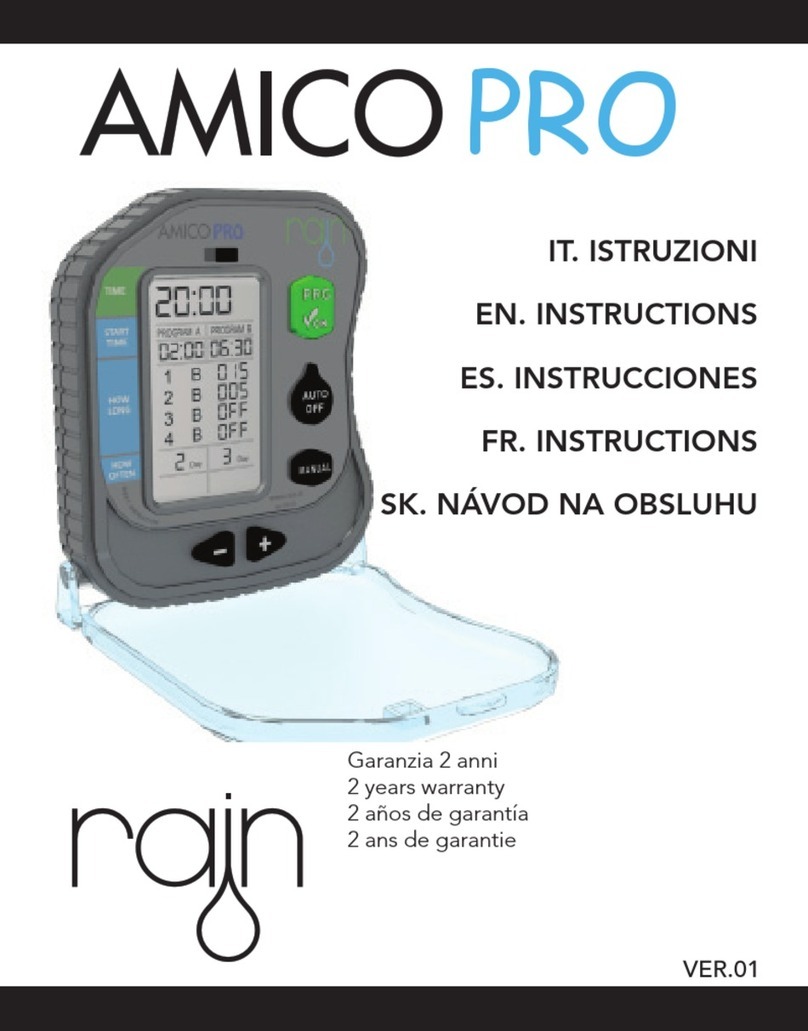
Rain
Rain AMICO PRO instructions
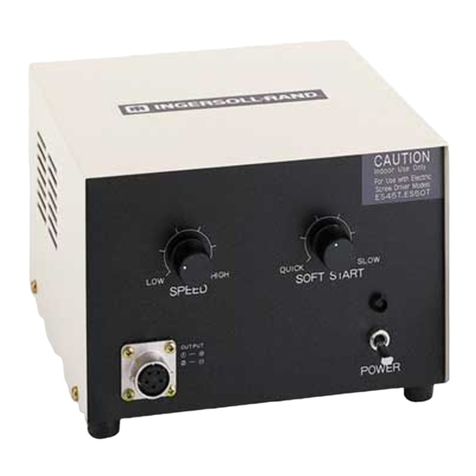
Ingersoll-Rand
Ingersoll-Rand Delvo ESCB50 Product information
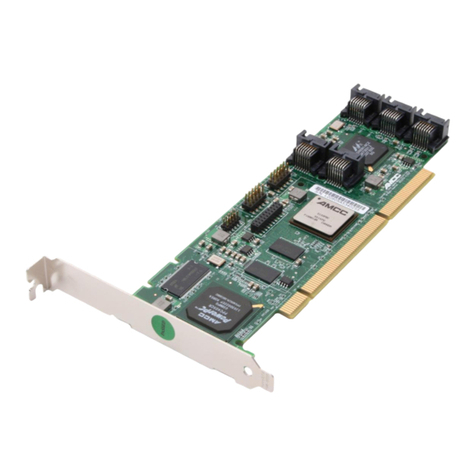
3Ware
3Ware 9550SXU-4LP-SGL - Pci-x Sataraid Quick install guide

VIPA
VIPA System 100V Series manual

